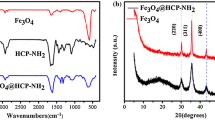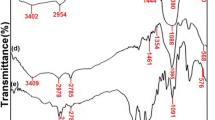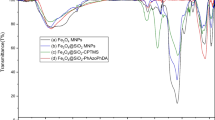Abstract
In the present study, a poly (vinylbenzyl chloride) grafted Fe3O4 nanoparticle (Fe3O4@PVBC) was prepared by surface-initiated reversible addition fragmentation chain transfer (SI-RAFT) polymerization and subsequently coated with tris (aminoethyl) amine (TAEA). Then, Fe3O4@PVBC-TAEA nanoparticles were utilized as a novel adsorbent for removal of Pb(II) from aqueous media and optimal adsorption conditions were determined with response surface methodology (RSM). The used adsorbent was characterized by using X-ray photoelectron spectroscopy (XPS), transmission electron microscopy (TEM), and vibrating sample magnetometer (VSM). RSM with central composite design (CCD) was carried out to evaluate the effect of initial pH, initial Pb(II) concentration (C0, mg/L), adsorbent dosage (mg), and contact time (min). The optimum initial pH, C0, adsorbent dosage, and contact time were found to be 5.88, 46.51 mg/L, 17.41 mg, and 108.21 min, respectively. The maximum removal efficiency and adsorption capacity were 97.07% and 129.65 mg/g under these conditions, respectively. The kinetic data revealed that the adsorption mechanism could be best explained by the pseudo-second-order and Weber-Morris models. The isotherm studies found that both the Langmuir and Freundlich isotherm models fitted the experimental data well. The thermodynamic analysis indicated that the adsorption nature is exothermic, applicable, and spontaneous.









Similar content being viewed by others
References
Afshar A, Sadjadi SAS, Mollahosseini A, Eskandarian MR (2016) Polypyrrole-polyaniline/Fe3O4 magnetic nanocomposite for the removal of Pb(II) from aqueous solution. Korean J Chem Eng 33:669–677
Ahmad R, Hasan I (2016) Optimization of the adsorption of Pb(II) from aqueous solution onto PAB nanocomposite using response surface methodology. Environ Nanotechnol Monit Manage 6:116–129
Ahmadi A, Heidarzadeh S, Mokhtari AR, Darezereshki E, Harouni HA (2014) Optimization of heavy metal removal from aqueous solutions by maghemite (γ-Fe2O3) nanoparticles using response surface methodology. J Geochem Explor 147:151–158
Anna B, Kleopas M, Constantine S, Anestis F, Maria B (2015) Adsorption of Cd(II), Cu(II), Ni(II) and Pb(II) onto natural bentonite: study in mono- and multi-metal systems. Environ Earth Sci 73:5435–5444
Antonopoulou M, Chondrodimou I, Bairamis F, Giannakas A, Konstantinou I (2017) Photocatalytic reduction of Cr(VI) by char/TiO2 composite photocatalyst: optimization and modeling using the response surface methodology (RSM). Environ Sci Pollut Res 24:1063–1072
Bagbi Y, Sarswat A, Mohan D, Pandey A, Solanki PR (2017) Lead and chromium adsorption from water using L-cysteine functionalized magnetite (Fe3O4) nanoparticles. Sci Rep UK 7:7672–7686
Banaei A, Vojoudi H, Karimi S, Bahar S, Pourbasheer E (2015) Synthesis and characterization of new modified silica coated magnetite nanoparticles with bisaldehyde as selective adsorbents of Ag(I) from aqueous samples. RSC Adv 5:83304–83313
Bezerra MA, Santelli RE, Oliveira EP, Villar LS, Escaleira LA (2008) Response surface methodology (RSM) as a tool for optimization in analytical chemistry. Talanta 76:965–977
Calugaru IL, Neculita CM, Genty T, Zagury GJ (2019) Removal efficiency of As(V) and Sb(III) in contaminated neutral drainage by Fe-loaded biochar. Environ Sci Pollut Res 26:9322–9332
Chand P, Bafana A, Pakade YB (2015) Xanthate modified apple pomace as an adsorbent for removal of Cd(II), Ni(II) and Pb(II), and its application to real industrial wastewater. Int Biodeterior Biodegrad 97:60–66
Deng S, Zheng YQ, Xu FJ, Wang B, Huang J, Yu G (2012) Highly efficient sorption of perfluorooctane sulfonate and perfluorooctanoate on a quaternized cotton prepared by atom transfer radical polymerization. Chem Eng J 193-194:154–160
Devi V, Selvaraj M, Selvam P, Kumar AA, Sankar S, Dinakaran K (2017) Preparation and characterization of CNSR functionalized Fe3O4 magnetic nanoparticles: an efficient adsorbent for the removal of cadmium ion from water. J Environ Chem Eng 5:4539–4546
Djouani F, Herbst F, Chehimi MM, Benzarti K (2011) Synthesis, characterization and reinforcing properties of novel, reactive clay/poly (glycidyl methacrylate) nanocomposites. Constr Build Mater 25:424–431
Dubinin M, Radushkevich L (1947) Equation of the characteristic curve of activated charcoal. Proc Acad Sci Phys Chem Sec USSR 55:331–333
Elkady M, Hassan H, Hashim A (2016) Immobilization of magnetic nanoparticles onto amine-modified nano-silica gel for copper ions remediation. Materials 9:460–483
El-Kassas HY, Aly-Eldeen MA, Gharib SM (2016) Green synthesis of iron oxide (Fe3O4) nanoparticles using two selected brown seaweeds: characterization and application for lead bioremediation. Acta Ocenol Sin 35:89–98
Freundlich H (1906) Over the adsorption in solution. J Phys Chem 57:385–470
Grewal JK, Kaur M (2017) Effect of core-shell reversal on the structural, magnetic and adsorptive properties of Fe2O3-GO nanocomposites. Ceram Int 43:16611–16621
Gurgel LVA, Gil LF (2009) Adsorption of Cu(II), Cd(II), and Pb(II) from aqueous single metal solutions by succinylated mercerized cellulose modified with triethylenetetramine. Carbohyd Polym 77:142–149
Haiyan J, Qiuxiang Z, Ying Z (2016) Removal of Cd(II) and Pb(II) from aqueous solutions by modified polyvinyl alcohol. Desalin Water Treat 57:6452–6462
Ho YS, McKay G (1999) Pseudo-second order model for sorption processes. Process Biochem 34:451–465
Hosseinzadeh H, Pashaei S, Hosseinzadeh S, Khodaparast Z, Ramin S, Saadat Y (2018) Preparation of novel multi-walled carbon nanotubes nanocomposite adsorbent via RAFT technique for the adsorption of toxic copper ions. Sci Total Environ 640-641:303–314
Huang L, Zhou Y, Guo X, Chen Z (2015) Simultaneous removal of 2,4-dichlorophenol and Pb(II) from aqueous solution using organoclays: isotherm, kinetics and mechanism. J Ind Eng Chem 22:280–287
Imamoglu M, Tekir O (2008) Removal of copper(II) and lead(II) ions from aqueous solutions by adsorption on activated carbon from a new precursor hazelnut husks. Desalination 228:108–113
Jiang H, Zhang Y, Chen R, Sun M, Tong H, Xu J (2017) Preparation of ion imprinted magnetic Fe3O4 nanoparticles for selective remediation of Pb(II). J Taiwan Inst Chem Eng 80:184–191
Kalantari K, Ahmad M, Masoumi H, Shameli K, Basri M, Khandanlou R (2014) Rapid adsorption of heavy metals by Fe3O4/talc nanocomposite and optimization study using response surface methodology. Int J Mol Sci 15:12913–12927
Kalantari K, Ahmad MB, Fard Masoumi HR, Shameli K, Basri M, Khandanlou R (2015) Rapid and high capacity adsorption of heavy metals by Fe3O4/montmorillonite nanocomposite using response surface methodology: preparation, characterization, optimization, equilibrium isotherms, and adsorption kinetics study. J Taiwan Inst Chem Eng 49:192–198
Khayat Sarkar Z, Khayat Sarkar F (2013) Selective removal of lead(II) ion from wastewater using superparamagnetic monodispersed iron oxide (Fe3O4) nanoparticles as a effective adsorbent. Int J Nanosci Ser 9:109–114
Kuang S-P, Wang Z-Z, Liu J, Wu Z-C (2013) Preparation of triethylene-tetramine grafted magnetic chitosan for adsorption of Pb(II) ion from aqueous solutions. J Hazard Mater 260:210–219
Kumari M, Pittman CU, Mohan D (2015) Heavy metals [chromium(VI) and lead(II)] removal from water using mesoporous magnetite (Fe3O4) nanospheres. J Colloid Interface Sci 442:120–132
Lagergren S (1898) Zur theorie der sogenannten adsorption geloster stoffe. K Sven Vetensk Handl 24:1–39
Langmuir I (1918) The adsorption of gases on plane surfaces of glass, mica and platinum. J Am Chem Soc 40:1361–1403
Liu X, Shi X, Wang H, Zhang H (2014) Atom transfer radical polymerization of diverse functional SBA-15 for selective separation of proteins. Microporous Mesoporous Mater 200:165–173
Luo X, Yu H, Xi Y, Fang L, Liu L, Luo J (2017) Selective removal Pb(II) ions form wastewater using Pb(II) ion-imprinted polymers with bi-component polymer brushes. RSC Adv 7:25811–25820
Mall ID, Srivastava VC, Kumar GVA, Mishra IM (2006) Characterization and utilization of mesoporous fertilizer plant waste carbon for adsorptive removal of dyes from aqueous solution. Colloid Surf A 278:175–187
Melnyk IV, Pogorilyi RP, Zub YL, Vaclavikova M, Gdula K, Dąbrowski A, Seisenbaeva GA, Kessler VG (2018) Protection of thiol groups on the surface of magnetic adsorbents and their application for wastewater treatment. Sci Rep UK 8:8592–8604
Naiya TK, Bhattacharya AK, Das SK (2009) Adsorption of Cd(II) and Pb(II) from aqueous solutions on activated alumina. J Colloid Interface Sci 333:14–26
Naseem R, Tahir SS (2001) Removal of Pb(II) from aqueous/acidic solutions by using bentonite as an adsorbent. Water Res 35:3982–3986
Nikraftar N, Ghorbani F (2016) Adsorption of As(V) using modified magnetic nanoparticles with ascorbic acid: optimization by response surface methodology. Water Air Soil Pollut 227:178–195
Rajput S, Pittman CU, Mohan D (2016) Magnetic magnetite (Fe3O4) nanoparticle synthesis and applications for lead (Pb2+) and chromium (Cr6+) removal from water. J Colloid Interface Sci 468:334–346
Rajput S, Singh LP, Pittman CU, Mohan D (2017) Lead (Pb2+) and copper (Cu2+) remediation from water using superparamagnetic maghemite (γ-Fe2O3) nanoparticles synthesized by flame spray pyrolysis (FSP). J Colloid Interface Sci 492:176–190
Sadeghi S, Azhdari H, Arabi H, Moghaddam AZ (2012) Surface modified magnetic Fe3O4 nanoparticles as a selective sorbent for solid phase extraction of uranyl ions from water samples. J Hazard Mater 215-216:208–216
Şahan T, Öztürk D (2014) Investigation of Pb(II) adsorption onto pumice samples: application of optimization method based on fractional factorial design and response surface methodology. Clean Technol Environ 16:819–831
Şahan T, Ceylan H, Şahiner N, Aktaş N (2010) Optimization of removal conditions of copper ions from aqueous solutions by Trametes versicolor. Bioresour Technol 101:4520–4526
Şahan T, Erol F, Yılmaz Ş (2018) Mercury(II) adsorption by a novel adsorbent mercapto-modified bentonite using ICP-OES and use of response surface methodology for optimization. Microchem J 138:360–368
Sánchez J, Espinosa C, Pooch F, Tenhu H, Pizarro GC, Oyarzún DP (2018) Poly(N,N-dimethylaminoethyl methacrylate) for removing chromium(VI) through polymer-enhanced ultrafiltration technique. React Funct Polym 127:67–73
Santhosh C, Nivetha R, Kollu P, Srivastava V, Sillanpää M, Grace AN, Bhatnagar A (2017) Removal of cationic and anionic heavy metals from water by 1D and 2D-carbon structures decorated with magnetic nanoparticles. Sci Rep UK 7:14107–14117
Sarı A, Tuzen M (2009) Kinetic and equilibrium studies of biosorption of Pb(II) and Cd(II) from aqueous solution by macrofungus (Amanita rubescens) biomass. J Hazard Mater 164:1004–1011
Shen H-Y, Chen Z-X, Li Z-H, Hu M-Q, Dong X-Y, Xia Q-H (2015) Controlled synthesis of 2,4,6-trichlorophenol-imprinted amino-functionalized nano-Fe3O4-polymer magnetic composite for highly selective adsorption. Colloid Surf A 481:439–450
Sohbatzadeh H, Keshtkar AR, Safdari J, Fatemi F (2016) U(VI) biosorption by bi-functionalized Pseudomonas putida @ chitosan bead: modeling and optimization using RSM. Int J Biol Macromol 89:647–658
Song T, Yu C, He X, Lin J, Liu Z, Yang X, Zhang Y, Huang Y, Tang C (2018) Synthesis of magnetically separable porous BN microrods@Fe3O4 nanocomposites for Pb(II) adsorption. Colloid Surf A 537:508–515
Stenzel MH, Davis TP (2002) Star polymer synthesis using trithiocarbonate functional β-cyclodextrin cores (reversible addition–fragmentation chain-transfer polymerization). J Polym Sci A1 40:4498–4512
Sun Y, Ding X, Zheng Z, Cheng X, Hu X, Peng Y (2006) Magnetic separation of polymer hybrid iron oxide nanoparticles triggered by temperature. Chem Commun 26:2765–2767
Tabaraki R, Nateghi A, Ahmady-Asbchin S (2014) Biosorption of lead (II) ions on Sargassum ilicifolium: application of response surface methodology. Int Biodeterior Biodegradation 93:145–152
Tan Y, Chen M, Hao Y (2012) High efficient removal of Pb(II) by amino-functionalized Fe3O4 magnetic nano-particles. Chem Eng J 191:104–111
Taty-Costodes VC, Fauduet H, Porte C, Delacroix A (2003) Removal of Cd(II) and Pb(II) ions, from aqueous solutions, by adsorption onto sawdust of Pinus sylvestris. J Hazard Mater 105:121–142
Wang Y, Chen H, Xu Y, Sun J, Bai L, Qu R, Wang D, Yu L (2015) Synthesis of polyvinyltetrazole resin by combination of RAFT polymerization and click chemistry for adsorption of Hg(II). J Macromol Sci A 52:707–712
Weber WJ, Morris JCJC (1963) Kinetics of adsorption on carbon from solution. J Sanit Eng Div ASCE 89:31–60
White BR, Stackhouse BT, Holcombe JA (2009) Magnetic γ-Fe2O3 nanoparticles coated with poly-L-cysteine for chelation of As(III), Cu(II), Cd(II), Ni(II), Pb(II) and Zn(II). J Hazard Mater 161:848–853
Xia T, Guan Y, Yang M, Xiong W, Wang N, Zhao S, Guo C (2014) Synthesis of polyethylenimine modified Fe3O4 nanoparticles with immobilized Cu2+ for highly efficient proteins adsorption. Colloid Surf A 443:552–559
Yılmaz Ş, Şahan T, Karabakan A (2017) Response surface approach for optimization of Hg(II) adsorption by 3-mercaptopropyl trimethoxysilane-modified kaolin minerals from aqueous solution. Korean J Chem Eng 34:2225–2235
Acknowledgments
The authors thank Prof. Dr. Zekiye Suludere for TEM analysis.
Author information
Authors and Affiliations
Corresponding author
Ethics declarations
Conflict of interest
The authors declare that they have no conflict of interest.
Additional information
Responsible editor: Tito Roberto Cadaval Jr
Publisher’s note
Springer Nature remains neutral with regard to jurisdictional claims in published maps and institutional affiliations.
Electronic supplementary material
ESM 1
(DOCX 493 kb)
Rights and permissions
About this article
Cite this article
Yılmaz, Ş., Zengin, A., Akbulut, Y. et al. Magnetic nanoparticles coated with aminated polymer brush as a novel material for effective removal of Pb(II) ions from aqueous environments. Environ Sci Pollut Res 26, 20454–20468 (2019). https://doi.org/10.1007/s11356-019-05360-2
Received:
Accepted:
Published:
Issue Date:
DOI: https://doi.org/10.1007/s11356-019-05360-2




